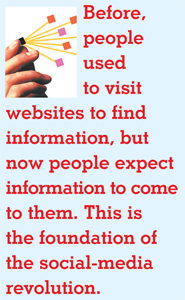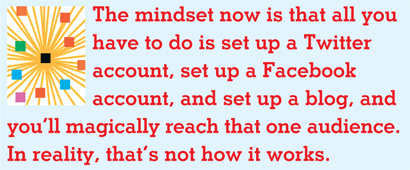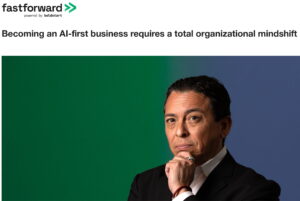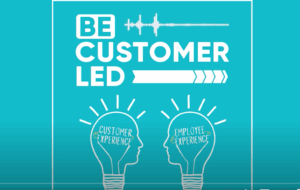Exhibitor Magazine ran a feature story on new media and how it is changing the world of event marketing. In our discussion, we expanded the scope beyond events to discuss how people were forcing the evolution of business overall. The result is something quite profound. People are now taking control of their online experiences driven by how they connect and to whom in the social web. This shift changes how people find, share and discover information within their networks of relevance and also reshapes the decision making process while influencing new behavior and outcomes.
People are now at the center of their very own egosystem and as a result, businesses are forced to evolve market strategies from a singular focus of creation to a holistic approach of co-creation.
The story begins here…
The 3F’s
Fans, friends, followers — these three relatively pedestrian words have recently gained new meaning and power amid the social-media revolution. A revolution that, for all intents and purposes, has been perpetuated by Facebook and Twitter. The “three Fs,” as author and sociologist Brian Solis calls them, are the new return on investment for marketers. However, measuring social-media return isn’t as simple as adding up your fans, friends, and followers and calling it a day. Rather, it’s about defining what, exactly, those three Fs mean to your company and, ultimately, your exhibit and event program.
In his book, “Engage! The Complete Guide for Brands and Business to Build, Cultivate, and Measure Success in the New Web,” Solis explains how to attach relevant value to the 3F’s, and why they’re important players in the movement he has dubbed “the socialization of business.”
EXHIBITOR Magazine: What do you think accounts for the mystique surrounding social-media marketing? That is, why are companies struggling with how to set goals for their social-media efforts, and measure the results?
Brian Solis: Social media is a tool we — people, attendees, individuals — brought to the table, and something we deemed worthy of our time, focus, and attention. That interest created a groundswell and forced a bottom-up revolution. Companies are struggling with how to set goals and measure results because there aren’t established processes, methodologies, best practices, or even case studies to demonstrate how social media influences marketing. So, while companies often recognize the opportunities to incorporate social media into their marketing efforts, very few have the answers as to why it works.
Compare that to conventional marketing and sales, which are established and known quantities. The tactics, strategies, and metrics associated with them have been proven successful and thus introduced to us, and have been something we’ve had to master versus something we had a hand in creating. The mistake marketers make is that they try to bring traditional tactics (how to reach an audience, target a demographic, etc.) to social media. It simply won’t work because there isn’t “one” audience to target anymore. It’s been replaced by a series of interconnected groups. Basically, social media set out to revolutionize everything marketers were working against.
EM: How can marketers respond to this revolution?
Brian: Social media are just channels to reach people. The opportunities are as diverse as existing and potential customers. But what’s to say those individuals want to connect with your company? As a marketer, you have to define the basis of that connection. The mindset now is that all you have to do is set up a Twitter account, set up a Facebook account, and set up a blog, and you’ll magically reach that one audience. In reality, that’s not how it works.

As consumers, you and I are setting up our own information networks. How we learn and what we share with others is governed by those with whom we connect via social media. Before, people used to visit websites to find information, but now people expect information to come to them. This is the foundation of the social-media revolution. You have to ask yourself, “Who am I trying to reach (attendees, partners, speakers)? Where are they going for information (Facebook, Twitter, blogs)?” and then design your marketing programs around reaching each one of those segments.
EM: There is a section in your book that talks about “connecting from the heart.” Why is it important to establish an emotional connection with a social-media audience?
Brian: The social-media landscape is essentially personal. Look at what people are sharing and responding to on Facebook, Twitter, and blogs. If you looked at a word cloud based on what people are posting, you would find that the most often used words always have something to do with emotion. That’s because social media is emotional, and it’s all about the individual. When you introduce classic marketing and sales to a platform that’s personal and emotional, you’re going to be met with resistance, hate, anger, and resentment because you represent everything they’re moving away from. This is when research and empathy are important.
As a marketer, you have to spend time learning the emotional touchpoints of your audience. That’s how you, as a marketer, enter the discussion. Spark a series of conversations and introduce solutions in a social network that’s relevant to your audience, and you’ll earn a place within that community. And, ultimately, you can turn emotional aspects into tangible metrics and tactics. The practice of social media is an earned privilege. Your relationships and stature in that community are all a reflection of what you’ve earned through participation.
EM: How do you leverage relationships to reach your marketing goals?
Brian: Conversations take place with or without you. Facebook and Twitter just allow you to peer into conversations to see what people are thinking and saying. What you see is people talking. However, what do we, as marketers, do with this information? We sit around our conference table and come up with messages and strategies to try and convince our audience that we are what we say we are. Eventually, we start to detach from what we’re trying to do, and end up alienating that audience because we’re obsessed with ourselves and what we want to say, rather than thinking about what our audience wants (and needs) to hear.
Social media is just that — social. So how do you take what your company offers and present it to your audience via social media? Start with your mission statement. Ask yourself “Would I tweet it? Would I see that and retweet that?” The answer is probably “No.” Social media are massive networks rich with common experiences. Tie your mission statement to that idea, and you have a much higher probability of earning attention. After all, that’s what it’s all about — getting attention.
EM: How can companies make the transition from simply using social media to get attention, to actually benefiting from social media?
Brian: What companies are doing now is just what they think they’re supposed to be doing. It’s completely reactionary. You have to understand what you’re trying to accomplish before you can figure out how to benefit from social media. What is your mission? What is your higher purpose? It probably has something to do with creating better customer and attendee experiences through your events and exhibits, and ultimately increasing sales.

ROI is elusive when you look at it as the number of engagements or Twitter followers. What’s the return on those fans, friends, and followers? Nothing, because they don’t carry substantive value. You have to focus on the return you want, which is likely increased sales. So think about how you can use social media to increase sales, and work backwards.
For example, let’s say you launch a Facebook campaign to get 1,000 “likes” for your brand page. You make your goal of 1,000, but what’s to say those people will attend your event or even visit the page at a later date? You have to offer them something of value in order to create a social consumer. That social consumer might then provide feedback on the event and even influence peers to attend. Figure out what your audience wants, and give it to them — over and over. You have to give them a reason to both connect and come back.
EM: Are there any secrets to achieving social-media success?
Brian: After working in social engagement since the mid-90s, one thing I’ve realized is that I have yet to create a template. People are different, and you have to consider what influences them and what motivates them. Social media represents the socialization of business — it’s of the people and for the people. So you have to engage those people in order to build a larger, social-minded community for your company, which means you have to learn a new way to communicate.
Instead of casting a fishing line to lure people in, you have to go to people and actually steer their actions and experiences. This has its inherent disadvantages because you’re not as in control as you like, but at the same time, not everyone is a leader. Some people are still looking for insight and direction, and marketers now have a platform to provide that.
But ultimately, it comes back to the three Fs — that’s where the future of social media lies. Fans, friends, and followers are becoming intensely influential, and are, in essence, becoming the brand, which is why earning a place in the social-networking community is imperative for today’s marketers.
CONTINUING EDUCATION
With chapters such as Defining the Rules of Engagement, The Social Marketing Compass, and Unveiling the New Influencers, Engage! The Complete Guide for Brands and Business to Build, Cultivate, and Measure Success in the New Web serves as a veritable social-media textbook for marketers and business strategists. That’s because it goes beyond simply stating the case for social media, it outlines how professionals should be using it to create communities, promote brand awareness, and harness the power of a new crop of influencers. And that’s just the beginning. Additional chapters dissect everything from planning to vendor-relationship management and social-media metrics — all within the framework of explaining what, exactly, all this information means to business.
Connect with Brian Solis on Twitter, LinkedIn, Facebook
 Now on iTunes!
Now on iTunes!







“…You have to offer them something of value in order to create a social consumer…” . Yep, totally agree – with my customers, it comes in two flavors – appreciation AND opportunity.
Well said Aaron!
Agree with you, Aaron … both value and value proposition. Social media is about information and relationships that empower something beyond the follow or like. If entrepreneurs, companies and other organizations don’t take these opportunities to the next levels (and let’s be honest, not every customer or prospect wants a relationship), we lose the impact of social and it becomes no different than the mainstream advertising outlets that don’t connect with people –the whole marketing TO instead of WITH situation.
As for the “egosystem” (Brian), I like a quote from Walter Cronkite: “There’s a little more ego involved in these jobs than people might realize.”
This is true for anyone in the social media space, whether they are a consumer participant or a creator in some capacity. Social has always been part of both business and humanity; now it’s part of the Internet too — and creating social commerce.
I like the “egosystem” terminology. Today’s social networks allow us to completely tailor our surroundings to our needs and desires. I’m also in complete agreement with “Conversations take place with or without you.” Social Media Monitoring can definitely help you find those conversations, so you can become a supportive and trusted participant in those conversations to both protect and build brand loyalty.
Indeed Brian…words to live and work by.
More great information, Brian. I help hospitals engage patients through social media, and the part of your interview that resonates the most with me is “connecting from the heart” and the power of emotion. Although I rarely watched Oprah, I caught her final show last week. One of her key points was the power of validation: Do you see me? Do you hear me? Does what I say mean anything to you? All businesses could benefit from having social media conversations that validate their fans, friends and followers.
The tools dont matter, eg Twitter, it’s what you achieve with them that counts.
What I love that you say so clearly Brian is that we all love instant gratification, and too many people think social media is about the quick win. People are about relationships and without one the best we can hope for is a short-term hook-up which creates no meaningful value for either party. That’s why the title of your book, ENGAGE! makes so much sense because we have to relate, exchange value, build trust and then eventually, if it makes sense, we can transact something worthwhile.
Just like any other marketing plan, you need to go into social media with a strategy in place. You need to have specific goals and ways to achieve those goals. As you mentioned, just setting up an account won’t do you much good.
I love the analogy of steering actions versus casting a line and hoping they come. So true! The rules haven’t been written about these great technologies but anything unique I love to read. You reminded me I need to get your book. My goal is to get it read it and implement some ideas this summer
I enjoyed how you responded to the question of transitioning a social media following into something that is actually beneficial to that company. This is the trickiest facet of social media. While its one thing to have 1000 likes on a Facebook page, it is quite another if this following is engaged and helping you meet the goals you set out to accomplish through social media. This is what we all need to figure out for ourselves.
I enjoyed how you responded to the question of transitioning a social media following into something that is actually beneficial to that company. This is the trickiest facet of social media. While its one thing to have 1000 likes on a Facebook page, it is quite another if this following is engaged and helping you meet the goals you set out to accomplish through social media. This is what we all need to figure out for ourselves.
Great article there, I think twitter is very helpful.
You’ve got awesome insights here that I suddenly begin to question things, like if social media is all about emotions and you have to reach your marketing goals with it – is there such a thing as ‘subliminal social media marketing’ where you converse with your friends, fans or followers under the guise of a more personal interaction where the conversation will subtly lead to a discussion of your product or service?
Indeed Aaron. Some nicely refer to it as aspirational engagement or marketing, but at the same time, it’s marketing to outcomes though unmarketing techniques. The question comes down to intention and finally execution (black hat, grey hat, white hat, etc.)
I loved this quote to me it says it all, “You have to paint a picture and then put your customer into it.” It’s all about stories and emotion – connection with your market that cannot be faked – ultimately now the customer will tell you whether you are on track by engaging with you – or not! This will tell you ahead of your sales stats if you are going to have a financially productive year lol